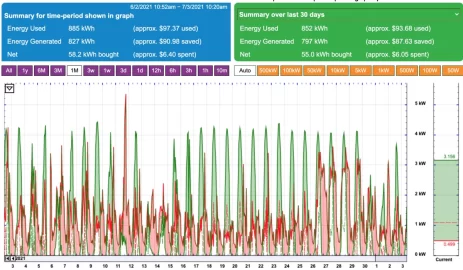We have an existing 2 array system. The original is field mounted and the second is on a tall pole. The pole mount has ten 270w Itek units (made in WA for discount) with a 2700 watt capacity and the original older array is composed of 15 Silicon Energy 195w panels. Design capacity 5,625 kW. The current inverter is a 10 yr old Aurora PowerOne 2 channel 4200w inverter. It's working fine but tops out at 4200watts which is less than the 2 arrays capacity.
Adding panels to the pole mount is not an option, however, it might be possible the field-mount array. Higher output could be achieved there though there is a caveat. Silicon Energy went bankrupt as panel failures started popping up. They are made from laminated tempered glass which can delaminate over time. They have also had issues recently cropping up with bypass diode failures which can lead to a fire. We have one panel that is starting to delaminate. We are trying to decide whether to limit liability by replacing the SE panels, but that would also mean a new inverter. Theoretically, we could boost system capacity to around 6.7kW and perhaps boost daily gains by addressing spring and fall shading issues on pole mount by a switch to microinverters. I will be getting a quote for options soon but would like to better understand the pluses and minuses of the options. Given that we were sold this system with a 20 yr warranty on the SE panels I am going to be pushing for a trade-in credit or at cost discount for the new hardware. We'll see. The company is a good one and I was one of their early customers.
Adding panels to the pole mount is not an option, however, it might be possible the field-mount array. Higher output could be achieved there though there is a caveat. Silicon Energy went bankrupt as panel failures started popping up. They are made from laminated tempered glass which can delaminate over time. They have also had issues recently cropping up with bypass diode failures which can lead to a fire. We have one panel that is starting to delaminate. We are trying to decide whether to limit liability by replacing the SE panels, but that would also mean a new inverter. Theoretically, we could boost system capacity to around 6.7kW and perhaps boost daily gains by addressing spring and fall shading issues on pole mount by a switch to microinverters. I will be getting a quote for options soon but would like to better understand the pluses and minuses of the options. Given that we were sold this system with a 20 yr warranty on the SE panels I am going to be pushing for a trade-in credit or at cost discount for the new hardware. We'll see. The company is a good one and I was one of their early customers.


 If in doubt I default to best practice and my three systems,
If in doubt I default to best practice and my three systems,
